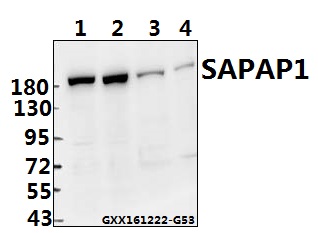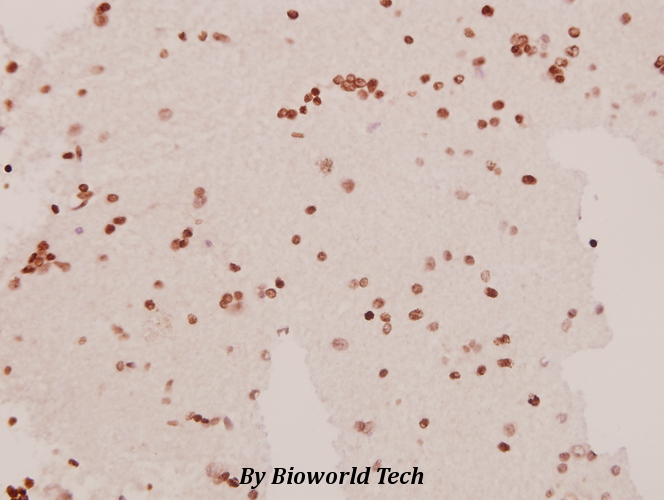Product Name :
SAPAP1 (E817) polyclonal antibody Background :
Members of the postsynaptic density-95 (PSD-95)/SAP90 family of membraneassociated guanylate kinase (MAGUK) proteins function as multimodular scaffolds that organize protein-signaling complexes at neuronal synapses. PSD-95/SAP90 binds guanylate kinase-associated protein (GKAP), also designated GK domain-binding protein, DAP-1-α, DAP-1-β, PSD-95 binding protein, PSD-95/SAP90 associated protein, or SAPAP1, through the guanylate kinase domain. SAPAP1 is expressed widely in neurons of the cortex and hippocampus and in the Purkinje and granule cells of the cerebellum. N-terminal splice variants of SAPAP1 are expressed as 95 and 130 kDa proteins. SAPAP1 is localized specifically in the PSD of glutamatergic synapses, consistent with its direct interaction with PSD-95 family proteins. Product :
Rabbit IgG, 1mg/ml in PBS with 0.02% sodium azide, 50% glycerol, pH7.2 Storage&Stability :
Store at 4°C short term. Aliquot and store at -20°C long term. Avoid freeze-thaw cycles. Specificity :
SAPAP1 (E817) polyclonal antibody detects endogenous levels of SAPAP1 protein. Immunogen :
Synthetic peptide, corresponding to amino acids 791-840 of Human SAPAP1. Conjugate :
Unconjugated Modification :
Unmodification
SAPAP1 (E817) polyclonal antibody Background :
Members of the postsynaptic density-95 (PSD-95)/SAP90 family of membraneassociated guanylate kinase (MAGUK) proteins function as multimodular scaffolds that organize protein-signaling complexes at neuronal synapses. PSD-95/SAP90 binds guanylate kinase-associated protein (GKAP), also designated GK domain-binding protein, DAP-1-α, DAP-1-β, PSD-95 binding protein, PSD-95/SAP90 associated protein, or SAPAP1, through the guanylate kinase domain. SAPAP1 is expressed widely in neurons of the cortex and hippocampus and in the Purkinje and granule cells of the cerebellum. N-terminal splice variants of SAPAP1 are expressed as 95 and 130 kDa proteins. SAPAP1 is localized specifically in the PSD of glutamatergic synapses, consistent with its direct interaction with PSD-95 family proteins. Product :
Rabbit IgG, 1mg/ml in PBS with 0.02% sodium azide, 50% glycerol, pH7.2 Storage&Stability :
Store at 4°C short term. Aliquot and store at -20°C long term. Avoid freeze-thaw cycles. Specificity :
SAPAP1 (E817) polyclonal antibody detects endogenous levels of SAPAP1 protein. Immunogen :
Synthetic peptide, corresponding to amino acids 791-840 of Human SAPAP1. Conjugate :
Unconjugated Modification :
Unmodification
-
 Western blot (WB) analysis of SAPAP1 (E817) polyclonal antibody at 1:500 dilution Lane1:The Brain tissue lysate of Mouse(40ug) Lane2:The Brain tissue lysate of Rat(40ug) Lane3:U-87MG whole cell lysate(40ug) Lane4:U-251MG whole cell lysate(40ug)
Western blot (WB) analysis of SAPAP1 (E817) polyclonal antibody at 1:500 dilution Lane1:The Brain tissue lysate of Mouse(40ug) Lane2:The Brain tissue lysate of Rat(40ug) Lane3:U-87MG whole cell lysate(40ug) Lane4:U-251MG whole cell lysate(40ug) -
 Immunohistochemistry (IHC) analyzes of SAPAP1 (E817) pAb in paraffin-embedded human brain carcinoma tissue at 1:50.
Immunohistochemistry (IHC) analyzes of SAPAP1 (E817) pAb in paraffin-embedded human brain carcinoma tissue at 1:50.
Bioworld Biotech only provide peptides for our antibodies and do not provide additional peptide customization services.
Price/Size :
USD 368/1mg/vial
Tips:
For phospho antibody, we provide phospho peptide(0.5mg) and non-phospho peptide(0.5mg).Describe :
Blocking peptides are peptides that bind specifically to the target antibody and block antibody binding. These peptide usually contains the epitope recognized by the antibody. Antibodies bound to the blocking peptide no longer bind to the epitope on the target protein. This mechanism is useful when non-specific binding is an issue, for example, in Western blotting (WB) and Immunohistochemistry (IHC). By comparing the staining from the blocked antibody versus the antibody alone, one can see which staining is specific; Specific binding will be absent from the western blot or IHC performed with the neutralized antibody.Formula:
Synthetic peptide was lyophilized with 100% acetonitrile and is supplied as a powder. Reconstitute with 0.1 ml DI water for a final concentration of 10 mg/ml.The purity is >90%,tested by HPLC and MS.
Storage:
The freeze-dried powder is more stable. For short time at 2-8°C. For long term storage store at -20°C.
Note :
This product is for research use only (RUO only). Not for use in diagnostic or therapeutic procedures.
 SAPAP1 (E817) polyclonal antibody
SAPAP1 (E817) polyclonal antibody  Datasheet
Datasheet COA
COA MSDS
MSDS SHIP
SHIP